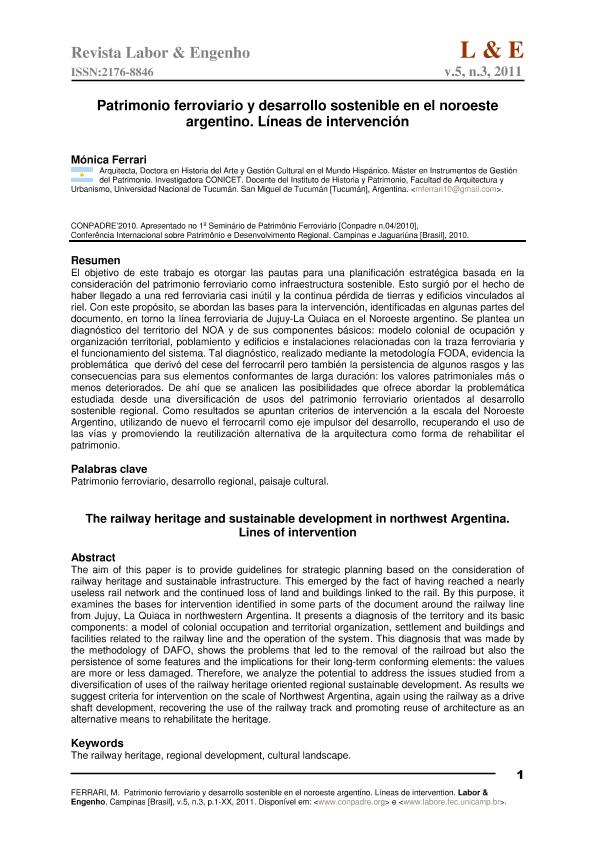Artículo
El objetivo de este trabajo es otorgar las pautas para una planificación estratégica basada en la consideración del patrimonio ferroviario como infraestructura sostenible. Esto surgió por el hecho de haber llegado a una red ferroviaria casi inútil y la continua pérdida de tierras y edificios vinculados al riel. Con este propósito, se abordan las bases para la intervención, identificadas en algunas partes del documento, en torno la línea ferroviaria de Jujuy-La Quiaca en el Noroeste argentino. Se plantea un diagnóstico del territorio del NOA y de sus componentes básicos: modelo colonial de ocupación y organización territorial, poblamiento y edificios e instalaciones relacionadas con la traza ferroviaria y el funcionamiento del sistema. Tal diagnóstico, realizado mediante la metodología FODA, evidencia la problemática que derivó del cese del ferrocarril pero también la persistencia de algunos rasgos y las consecuencias para sus elementos conformantes de larga duración: los valores patrimoniales más o menos deteriorados. De ahí que se analicen las posibilidades que ofrece abordar la problemática estudiada desde una diversificación de usos del patrimonio ferroviario orientados al desarrollo sostenible regional. Como resultados se apuntan criterios de intervención a la escala del Noroeste Argentino, utilizando de nuevo el ferrocarril como eje impulsor del desarrollo, recuperando el uso de las vías y promoviendo la reutilización alternativa de la arquitectura como forma de rehabilitar el
patrimonio. The aim of this paper is to provide guidelines for strategic planning based on the consideration of railway heritage and sustainable infrastructure. This emerged by the fact of having reached a nearly useless rail network and the continued loss of land and buildings linked to the rail. By this purpose, it examines the bases for intervention identified in some parts of the document around the railway line from Jujuy, La Quiaca in northwestern Argentina. It presents a diagnosis of the territory and its basic
components: a model of colonial occupation and territorial organization, settlement and buildings and facilities related to the railway line and the operation of the system. This diagnosis that was made by the methodology of DAFO, shows the problems that led to the removal of the railroad but also the persistence of some features and the implications for their long-term conforming elements: the values are more or less damaged. Therefore, we analyze the potential to address the issues studied from a
diversification of uses of the railway heritage oriented regional sustainable development. As results we suggest criteria for intervention on the scale of Northwest Argentina, again using the railway as a drive shaft development, recovering the use of the railway track and promoting reuse of architecture as an alternative means to rehabilitate the heritage.
Patrimonio ferroviario y desarrollo sostenible en el noroeste Argentino. Líneas de Intervención
Título:
The railway heritage and sustainable development in northwest Argentina. Lines of intervention
Fecha de publicación:
06/2011
Editorial:
Universidade Estadual do Campinas
Revista:
Revista Labor & Engenho
ISSN:
2176-8846
Idioma:
Español
Tipo de recurso:
Artículo publicado
Resumen
Palabras clave:
Railway Heritage
,
Regional Development
,
Cultural Landscape
Archivos asociados
Licencia
Identificadores
Colecciones
Articulos(CCT - NOA SUR)
Articulos de CTRO.CIENTIFICO TECNOL.CONICET - NOA SUR
Articulos de CTRO.CIENTIFICO TECNOL.CONICET - NOA SUR
Citación
Ferrari, Monica Rossana; Patrimonio ferroviario y desarrollo sostenible en el noroeste Argentino. Líneas de Intervención; Universidade Estadual do Campinas; Revista Labor & Engenho; 5; 3; 6-2011; 1-19
Compartir




